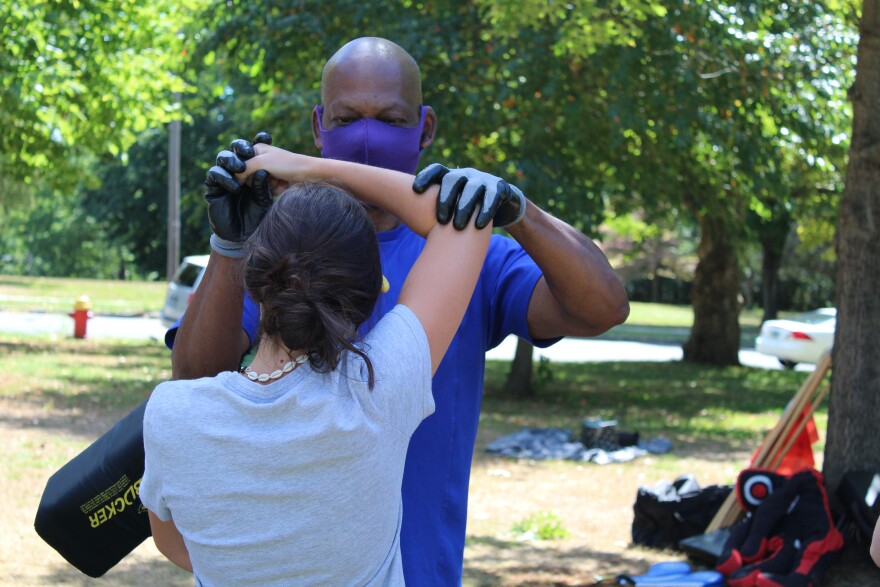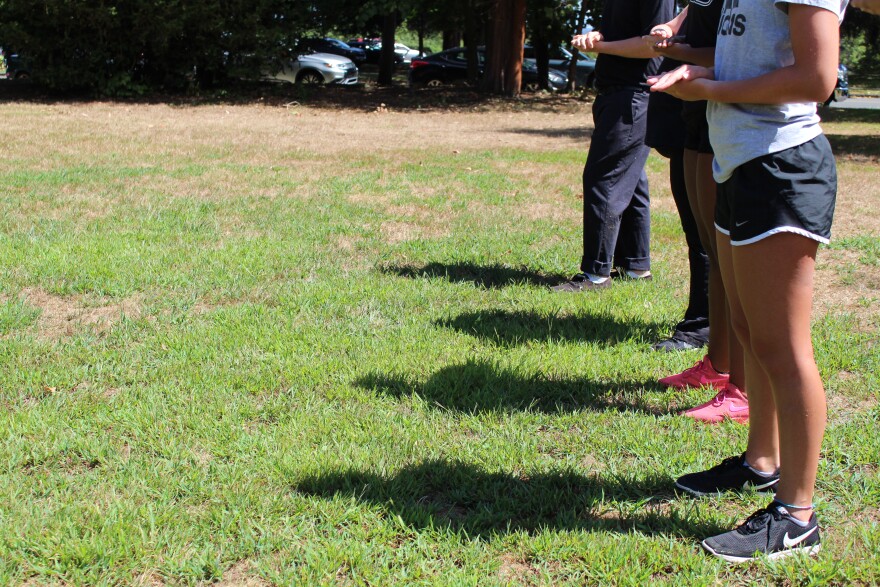Shootings, car rammings and assaults at protests across the country have prompted some racial justice activists to consider their options for self-defense. Activists from Manchester, Connecticut, signed up for a martial arts training for protesters after deaths in Kenosha, Wisconsin and Portland, Oregon.
On Sunday, August 30, about a dozen women, men and children stood shoulder-to-shoulder in gym shoes at Elizabeth Park in West Hartford. Cornell Lewis, the instructor and 4th degree black belt, gripped Taekwondo kick pads in each hand. He urged a young woman to practice punching them.
“Okay, Mayweather!” Lewis compared his trainee to the professional boxer, Floyd Mayweather, after catching a hard blow.
To people passing by, this might have looked like a workout class if not for the Black Lives Matter banner propped up near Lewis’s gym bag.
“What we were doing is martial arts for social protest,” Lewis explained. “A lot of people go out on the streets and they’re confronted with the police or counter protesters and they don’t know what to do. So we’re teaching basic stuff: blocking, kicking, how to roll an opponent if they’re on the ground and surveillance.”

Lewis said this is one of half a dozen trainings he’s led since thousands of protesters took to the streets to demand racial justice in honor of George Floyd, the Black man who was killed by police in Minneapolis, Minnesota this May. Lewis said his training is about self-defense, not retaliation.
“We look to diffuse all situations,” Lewis said, “However, if we have to, if we are attacked, if we are touched or spit upon, then we will defend ourselves with just enough force to make sure our opponent is rendered helpless.”

Lewis is aware of the risk if the opponent is armed. He says he sets this boundary with police before a protest and explains what he is prepared to do in response to violence. He has not had an issue with law enforcement escalation this summer.
The trainees for the day are members of a racial justice organization called Power Up Manchester. Keren Prescott leads the group, which she said has about 1,000 followers on social media. She asked Lewis for help after one of their protests in Somers, Conn., turned violent in July. Prescott said she first knew there would be trouble when a woman in a vehicle sped up as her group was crossing the street. It escalated from there.
“Five times, counter-protesters crossed the double yellow lines on the street,” Prescott said. She had permission from the police department and her group was given a designated area to protest. “We were supposed to stay on our side of the sidewalk, and they crossed the street, and they broke our line, and attacked our people. No one was held accountable, even though the police were right there.”
The Somers Police Department did not immediately respond to requests for comment. The Journal Inquirer reports one protester was arrested that day.
Prescott set up this self defense training just days after a white teenager was charged with shooting and killing two protesters in Kenosha, Wisconsin. The protesters were demanding justice for Jacob Blake, a Black man who was shot seven times by police in view of three of his young sons.
“I’m completely changing as a result of what has happened most recently with Jacob Blake,” Prescott told the group, which includes her own three children, ages 16, 14 and nine. She said she is okay if her group loses followers because of her change in philosophy: “there are plenty of other movements you can join.”
She used to ask protesters to follow the non-violent philosophy of Dr. Martin Luther King Jr, like the thousands who marched in Washington on the 57th anniversary of his “I Have A Dream” speech on August 28. On the steps of the Lincoln Memorial, Reverend Al Sharpton alluded to these diverse points of view in the movement for racial justice:
“Some have different tactics, but we all are rising up,” Sharpton said, “We will get your knee off our neck. Enough is enough!”
Critics of Black Lives Matter protests claim unrest isn’t what King would have wanted. But scholars like Peniel Joseph found there is a long history of the Black community using"riots as the language of the unheard"--as well as self-defense. Joseph directs the Center for Race and Democracy at The University of Texas at Austin. His book, The Sword and the Shield, explores how Dr. King and Malcom X were not polar opposites. Joseph said Americans forget that Dr. King let armed deacons march with him. They were seen as protectors of the civil rights movement.
“I think in a democratic society, you legally have the right to defend yourself,” Joseph said. “As an organizing principle, does it make sense in a society that is predicated on such hugely racist violence? Organizers and organizations have to decide that for themselves.”
Joseph said Black Americans had to defend themselves from armed vigilantes like the Ku Klux Klan less than 100 years ago, and many in today’s movement recognize that legacy now.
“I’m not surprised that there’s going to be some who are interested in self defense,” Joseph said, “Especially when folks who are portraying themselves as armed citizen soldiers--but are really white supremacists--are using the 2nd Amendment and [air quote] ‘patrolling’ under the aegis of the 2nd Amendment.”
Joseph said while there is a history of Black self-defense, modern weapons make it more dangerous than ever to go that route. He said that’s why an estimated 20 million supporters of the Black Lives Matter movement largely practiced peaceful protest in May, June and July--and met violence from law enforcement.
At the self-defense training in West Hartford, Cornell Lewis split the Power Up Manchester group for role play. Half the group acted as counter-protesters. They chanted slogans like “All Lives Matter!” and “Make America Great Again!”.

The other half practiced as members of their own racial justice group. At Lewis’s cue-- “Formation!”--they lined up shoulder to shoulder. The counter-protesters advanced, so Lewis commanded two Power Up members to begin closing in on either side.
“Right flank!” Lewis directed one protester to move. “Left flank!” he said to another.
The Power Up center line marched with hands clasped at their chests, almost like singers in a choir. On Lewis’s signal, they opened their palms and held their arms out front.
“Attack!” said Lewis.
Both groups marched forward, but Power Up encircled the counter-protesters.
“We’re showing discipline,” Lewis said, “let’s try it again.”

Lewis grouped the trainees together for some final advice for what could come in the months leading up to the November election--and beyond.
“These people are not messing around.” he told them. He reminded the diverse group that Black members are targeted because of the color of the skin they were born with, “We don’t have a choice. We have to fight. So people that are helping us, they need to understand that and realize that we’re willing to face whatever it takes.”
He said it’s okay if some of the protesters are not prepared to risk their lives, but if something escalates he said, “make sure you get out of the way.”
Lewis’s training has yet to go mainstream in the Connecticut protest community. But he thinks more organizers will be interested as more counter-protesters feel emboldened by far-right rhetoric.

